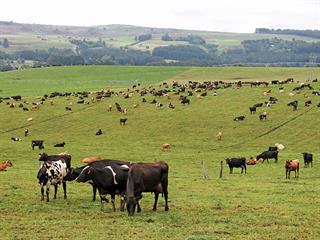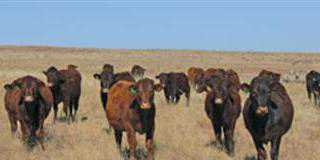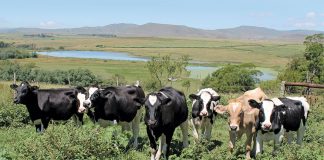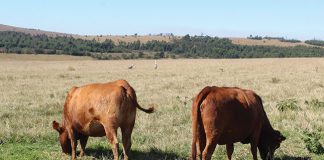
“Are you making money from milk, or are you making milk from money?” asks New Zealand agronomist, Will Henson.
This is an important question in an industry notorious for high production costs, tight profit margins and a fickle milk price. Grass pasture is the cheapest and most abundant feed source for dairy cattle in both South Africa and New Zealand. It therefore pays farmers to grow grass of the highest possible quality and have their cows convert it into milk efficiently and profitably.
“A dairy operation can achieve high production, but this is useless if it negatively affects its bottom line,” Henson told dairy farmers during a farmers’ information day in KwaZulu-Natal.

From left, Dave Sharpe of Barenbrug South Africa and Will Henson of Agriseeds in New Zealand, examine a ryegrass pasture in the KZN Midlands.
“It’s the profit per litre, not the number of litres produced, that’s important. On a pasture-based dairy operation, the more concentrate fed to the cows to boost milk production, the less pasture they graze. This undermines profitability.”
Pasture utilisation, or the amount of grass per hectare a dairy herd consumes, is the key indicator of the operational profitability of a pasture-based dairy farm. Supplementary feed should only supply those nutrients that a pasture grass cannot provide to produce milk optimally and cost-efficiently.
“Ideally, pasture utilisation should average 85% of the dry matter (DM) available per hectare. This requires improved and more intensive pasture management,” Henton stresses.
In both countries, ryegrass is the pasture of choice in pasture-based enterprises. Henton says it is crucial for a dairyman to understand the production, persistence, quality and utilisation of this pasture to maximise profit from it.
Daughter tillers
The tiller is the functional unit of a grass. A ryegrass tiller has its own roots, stem and leaves, and on average lives for just over 12 months. Any that live into winter will experience vernalisation, set seed and die.
“In spring, however, the ryegrass pasture will start regenerating itself by putting out daughter tillers. Every parent tiller will put out about three daughter tillers. If a farmer can get all three daughter tillers to survive, the pasture closes up. This is what we want.”
If only one ryegrass daughter tiller replaces its mother, the pasture remains the same. If no daughter tiller survives, the pasture regresses or dies out. According to Henson, there are two rules for promoting daughter tiller survival and thereby maximising pasture persistence, yield, quality and utilisation.
Graze ryegrass pasture either at the 2½-leaf or 3-leaf stage or at canopy closure, depending on which comes first. This ensures that daughter tillers are not starved of sunlight. A sign of canopy closure is ryegrass plants starting to fall over and exposing the undersides of their leaves. Sunlight reflecting off of the underside of ryegrass leaves creates a shimmering effect to the human eye.
Consistently graze ryegrass pasture down to clean and uniform residuals about 4cm high; this allows light down into the base of the pasture.
“Contrary to widespread belief, ryegrass does not store its nutrient reserves in its roots, but in the first 3cm to 4cm of the plant above ground level. Grazing or mowing a pasture to below 4cm will cut into the plant reserves, compromising its ability to recover.
“Alternately, leaving too much material above ground level will reduce the quality and palatability of the next grazing, resulting in a build-up of trash in the base of the pasture. This acts as a breeding ground for blight and facial eczema in humid conditions. If cows don’t graze to a clean and even residual and leave too much material behind, it’s useful to mow the camp after the cows have left to get the pasture down to the correct height.”
Once a ryegrass plant has been grazed down to 4cm, all of its energy reserves go into growing a new leaf. This first leaf is the smallest and will act as the ‘solar panel’ for photosynthesis and produce the energy needed to grow the second leaf. The second leaf is normally about 25% larger than the first leaf.
The growing ryegrass plant now has two ‘solar panels’ to produce energy for the growth of a third leaf that is typically 25% larger than the second leaf. From about the 2½-leaf stage in the plant’s regrowth, its reserves, stored in the crown, are fully recharged.
Ideal leaf stage
A ryegrass pasture should ideally be grazed at the 2½-leaf to 3-leaf stage. Grazing it at the 1-leaf stage, or even repeatedly at the 2-leaf stage, will most likely result in the pasture dying as it no longer has energy reserves, or cannot regenerate sufficient energy, to sustain itself.
A pasture at 1-leaf stage is at only 10% to 15% (1 500kg/ ha DM to 1 600kg/ ha DM) of its potential maximum DM yield. At the 2-leaf stage it is 30% to 40% (1 600 kg/ ha DM to 2 250 kg/ ha DM) of its potential yield. At the 3-leaf stage, it is at 45% to 55% (2 250 kg/ ha DM to 3 100kg/ ha DM). Grazing ryegrass pasture at the 2-leaf stage means losing out on more than half of its maximum DM yield.
Henson explains that supplementary feeding can be a good investment if forage is in short supply, and will allow the ryegrass pasture time to regenerate back to the 3-leaf stage.
“At this stage, the quality is as good as it’s going to get. A ryegrass plant can sustain a maximum of only three live leaves at a time. If it’s allowed to grow to the fourth and final leaf stage, the first leaf will die.”
Once there is dead material in a ryegrass pasture, the average quality can drop to a metabolisable energy (ME) level of about 10 MJ/ kg DM. At the 3-leaf stage, a ryegrass pasture’s average ME level is 11,5 MJ/ kg DM.
“When leaves start dying and decomposing, the pasture becomes less palatable and cows become reluctant to graze,” Henson adds.
At the 2½-leaf to 3-leaf stage, a ryegrass plant’s crude protein content is about 18%, the optimal level for a dairy cow to produce milk. Anything above this level is surplus to requirements. The potassium level declines and the calcium level increases, providing an excellent balance of nutrients. Grazing a ryegrass pasture before the 2½-leaf to 3-leaf stage will result in the cows consuming an imbalance of important nutrients. After the 3-leaf stage, the protein level is undesirably low.
Dry matter intake
“DM intake is the most important factor in milk production,” stresses Henson. The more DM in good quality ryegrass a cow eats, the better. A cow eating 20kg of good quality DM daily can produce about 2,25kg milk solids – almost 30l raw milk – daily.
“The only way that a cow can consume this quantity is if the ryegrass pasture quality is good – at the 3-leaf stage – and there is plenty of it. At the 3-leaf stage, the cow can get big mouthfuls of high quality feed and harvest the pasture most efficiently.
A cow should not waste time and energy trying to find good quality ryegrass. It will also digest good quality pasture more efficiently because of its high ME level.”
‘Nip-off graze’
When New Zealand dairy farmers plant new ryegrass pasture, they typically put a herd of young stock into this new pasture once the seedlings have 2½ leaves to give the pasture what Henson calls a “nip-off graze”. By this time, the young ryegrass plants’ roots are firmly established and will not be pulled out of the soil through grazing.
A nip-off graze stimulates the young plant’s single mother tiller to put out three daughter tillers, increasing the pasture density and boosting its yield. It also allows sunlight to penetrate to the base of the plant, boosting the three daughter tillers. In spring, it can be difficult to graze fast-growing pastures in time. Henton therefore advocates taking some camps out of the rotational grazing round to mow for silage.
“For best quality silage, cut ryegrass at the 3-leaf stage. Never let a ryegrass pasture intended for silage grow beyond the 3-leaf stage as this will shade the daughter tillers, resulting in poor quality silage. A pasture surplus in spring is also an opportunity to spray out poor-performing pastures for summer cropping,” he says.
Email Will Henson at [email protected].
This presentation was given at a Barenbrug SA Farmers’ Information Day held on 16 October 2015 in the Nottingham Road area of KwaZulu-Natal.













